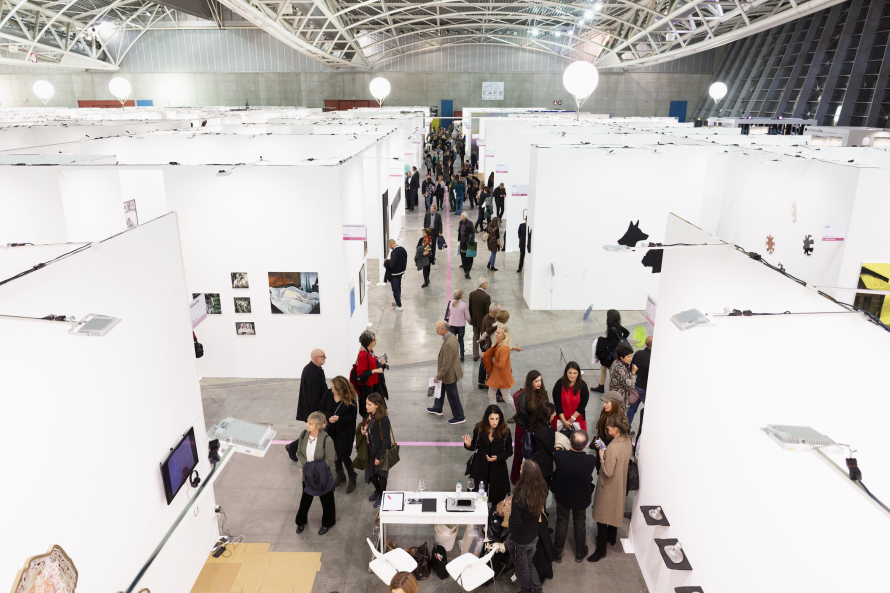
The only fair in Italy exclusively devoted to contemporary art, Artissima is widely considered to be one of the world’s top ten art fairs. Returning for its 26th edition at Turin’s Oval, which was built for skating events in the 2006 Winter Olympics, the fair presented 208 galleries from 43 countries and a variety of special projects spread throughout the city and surrounding Piedmont region from October 31 to November 3, 2019.
Directed by curator and art historian Ilaria Bonacossa, who received an MA in Curatorial Studies from Bard College and worked as research assistant for the 2003 Whitney Biennial and curator at the Fondazione Sandretto Re Rebaudengo until 2012, when she became the artistic director of the Museo d’Arte Contemporanea Villa Croce in Genoa, the fair is celebrated for championing pioneering practices and launching up-and-coming artists and galleries.
With a theme exploring the duality of desire and censorship, this year’s fair included seven sections: the Main Section, offering a selection of representative galleries on the international scene; New Entries, which featured emerging international players; Dialogue, which focused on the works of two artists shown in close dialogue with each other; Art Spaces & Editions, highlighting galleries, project spaces and non-profit initiatives; plus three sections curated by teams of international curators, including Present Future, showcasing emerging talent; Back to the Future, focusing on the rediscovery of pioneers of contemporary art; and Disegni, featuring all forms of contemporary drawing.
“It’s not just a fair,” Bonacossa told an interviewer in a special issue of La Stampa, Turin’s daily newspaper, that was published for the fair. "It’s an engaging experience that takes the audience on a trip around the world through the most interesting developments in art.”
We’ve chosen five galleries exhibiting six standout artists and collectives in four sections of Artissima that we believe live up to that goal.
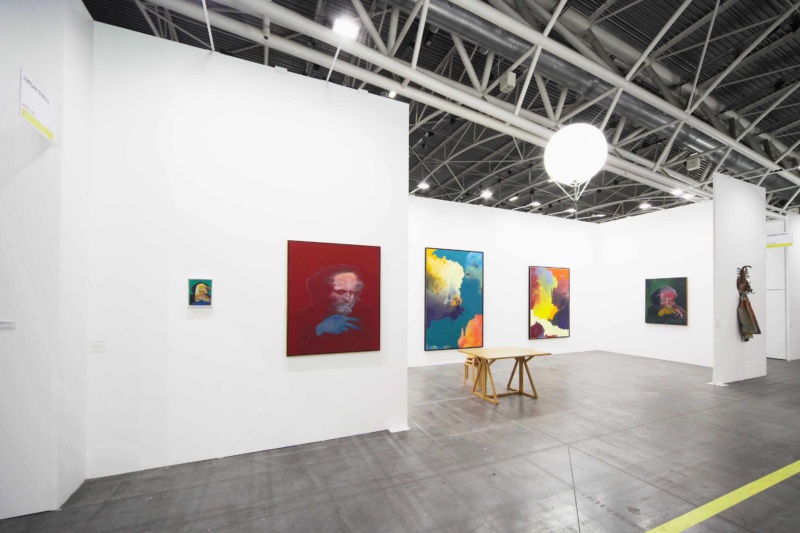
Gianni Politi at Galleria Lorcan O’Neill, Rome An Italian artist who was born in Rome in 1986 and lives and works there now, Gianni Politi considers himself to be an abstract painter, even though he also paints figurative canvases and makes referential sculptures that draw from his own life. In its Main Section booth, Lorcan O’Neill exhibited large-scale abstractions made by pouring and spraying paint on canvas, which the artist then ripped and cut into smaller pieces and collaged onto a new stretched canvas that got reworked with solid areas of paint.
These works were paired with smaller-scale paintings of an old, bearded man that Politi has painted many times. He discovered the subject—Gaetano Gandolfi’s 1770 painting Study for a man with a beard—in a book several years ago and since it reminded him of his deceased father he made it his own. The canvases (all 2018–19) were further juxtaposed with a pair of sculptures that were fabricated after his symbolic tattoos, which he’s added to his body yearly. His cast bronze scorpion and tiger’s head (from 2017–18) have been turned into coat racks, upon which Politi has playfully placed abstract paintings that he had a tailor make into utilitarian jackets.
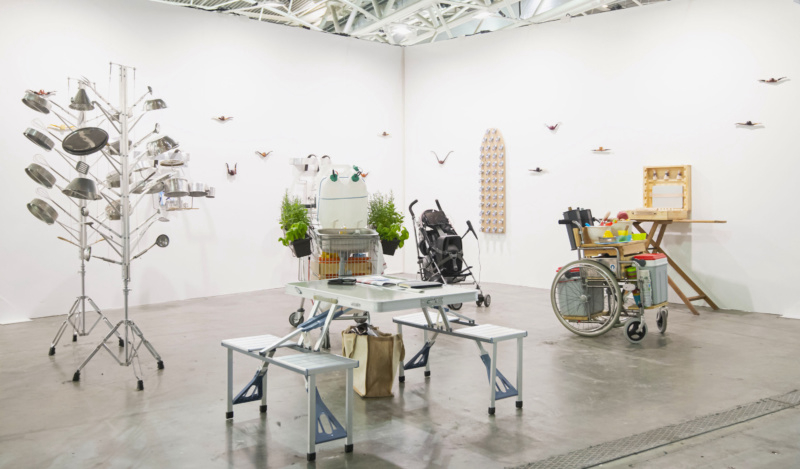
Opavivará! at A Gentil Carioca, Rio de Janeiro Exhibiting the Brazilian art collective Opavivará! in the Present Future section, A Gentil Carioca presented a relational booth for touching, massaging, printing, drinking, smoking and experimenting, where the audience was invited to socially interact. Co-joined smoking pipes lined the walls of the stand, while a baby stroller was turned a karaoke machine, a wheelchair sported a homemade bar for making mixed drinks and a shopping cart was transformed into a sink for washing dishes, as well as fruits and vegetables.
Adding a further party or carnival-like atmosphere to the booth, the four-person group showcased their percussion instruments made from assembled pots and pans that are played with whisks and wooden spoons, a set of rolling pins that can be used to apply animal patterns to revelers’ skins and an ironing board with added wheels that now functions as a back massager during these troubling political times; its punning title Vai Passar! translates from Portuguese as “This too shall pass!”
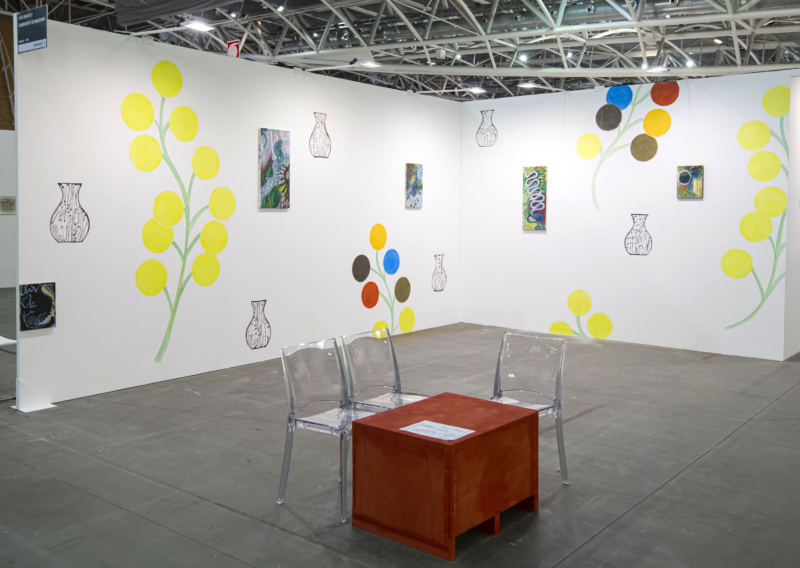
Ana Manso at Galleria Umberto Di Marino, Naples A Portuguese artist who was born in Lisbon in 1984, Ana Manso offers a more mythological gathering than her Brazilian counterparts. Marrying landscape with still life for an installation in Umberto Di Marino’s booth in the Disegni section of the fair, Manso pairs her gestural abstractions of clouds, suns and dragons with figurative walls drawings of jumbo clusters of grapes and ancient vessels used to store wine.
With even the gallery desk painted a rich red color of wine or clay, the installation—titled everything seeks a state of balance—references signs and symbols related to the artist’s life and environment, with the individual canvases capturing the fine elements (water, metal, wood, fire and earth) in performative brushstrokes that seem to ripple through time.
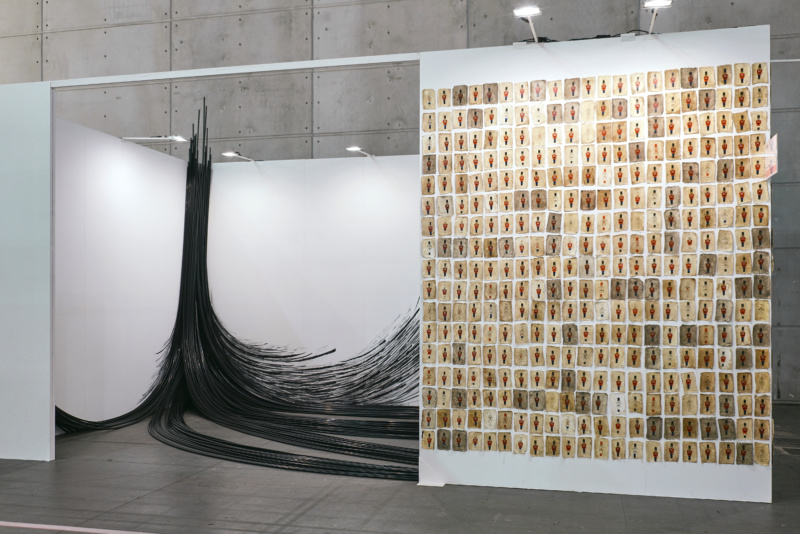
Muhannad Shono and Mohamed Monaiseer at Athr Gallery, Jeddah Pairing two Arab artists who work in contrasting ways, Athr Gallery presented Muhannad Shono’s massive abstract sculptural installation and small charcoal drawings inside its Main Section booth and Mohamed Monaiseer’s small-scale figurative paintings on its two outer walls highly effectively.
Saudi artist Shono created a symbolic oil well gushing black gold from PVC pipes and oil stick markings on the wall to reference his homeland’s dependency on the natural resource; titled The Caliph Seeks Asylum (2019), the work seeks to redirect the Arab psyche to higher ideals than the riches oil brings. Cairo-born Monaiseer takes on his country’s involvement in the Arab Spring in his series of Toy Soldier paintings (2015–18). These small-scale, un-stretched canvases portray this toy from children’s games of war on soiled bits of canvas—illustrating how themes of war and suppression are sadly ingrained in us from our childhoods.
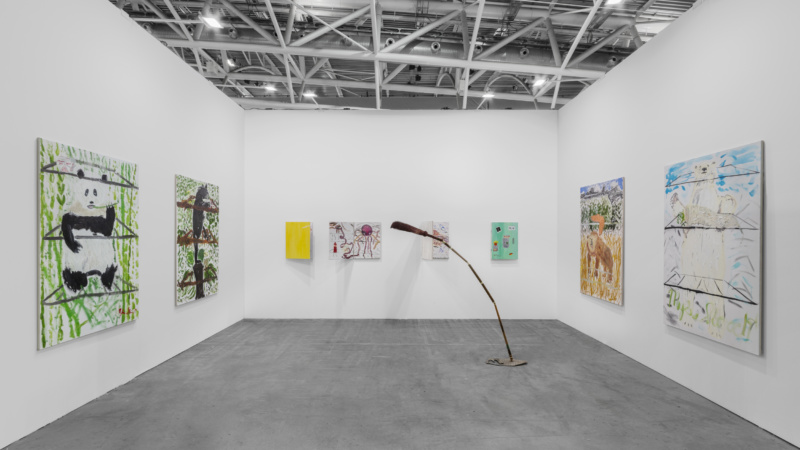
Myles Starr at Vin Vin, Vienna Exhibiting a new series of paintings that depict animals humorously inhabiting refrigerators at Vin Vin, American artist Myles Starr believes he has found a new taboo—peering into your host’s icebox. Considering sexuality in art commonplace by now, the Vienna-based painter and sculptor imagines a more surprising scenario of looking into a fridge and seeing a polar bear stealing a salmon, a panda munching on grass or an octopus grabbing some leftovers.
Rendered in a scumbling, sketchy painting style, the large-scale canvases and hinged smaller paintings are joined in the booth by an arching assemblage constructed from old pool sticks that are topped by a broom. Exhibited in the New Entries section, the mix shows why Artissima continues to attract adventurous artists and exhibitors looking to shake up the scene and collectors and curators who are seeking new ways of seeing an ever-changing world.



